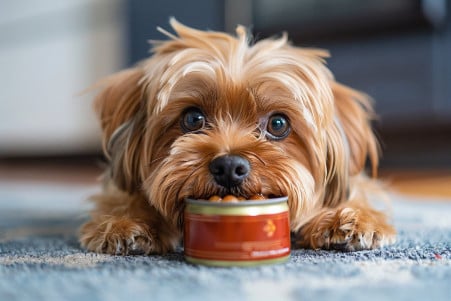Can Dogs Eat Spam? Unpacking the Risks of Processed Meats
9 February 2024 • Updated 8 February 2024

Spam may be calling your dog’s name, but is it safe to share this canned meat with your furry friend? Spam is not good for dogs because it is high in both fat and salt, which can cause dehydration, salt poisoning, and pancreatitis. The preservatives in even the ‘Lite’ versions of Spam are also bad for dogs. Stick to lower-fat, lower-salt, and less processed meats when giving your dog a treat.
This article will explore veterinary opinions and nutritional facts to explain the dangers and risks of giving Spam to dogs. It will also look at studies by animal nutritionists, toxicology research, and other research on the nutritional needs of dogs to explain why certain human foods, including those that are high in protein, can be harmful to our pets.
You will also find out how to make sure you’re making the best nutritional choices for your dog, so you can keep them healthy and happy.
Can dogs eat Spam?
Spam’s Nutritional Value and How It Affects Dogs
Spam, which is made up of pork, ham, salt, water, modified potato starch, sugar, and sodium nitrite, is not safe for dogs to eat. In just a 2-ounce serving, Spam has about 180 calories, 16 grams of fat, and a whopping 790 milligrams of sodium—none of which are in line with a dog’s dietary needs.
The high levels of sodium and fat in Spam can cause a number of health problems in dogs, including dehydration, pancreatitis, and salt poisoning, which can result in symptoms like excessive thirst, lethargy, and seizures, according to A-Z Animals.
Spam’s preservatives and additives, like sodium nitrite, can also be problematic for dogs, potentially leading to an increased risk of cancer and digestive problems. Even Spam’s ‘Lite’ and ‘Low Sodium’ versions have salt levels that are too high for dogs, according to Petfooled.
Instead, dogs can get the protein they need from healthier sources like steamed chicken, boiled eggs, or fish, all of which meet their dietary needs without the negative side effects of processed meats like Spam. However, it’s always important to work with a vet to create a diet that’s tailored to your dog’s specific health needs.
The Dangers of Too Much Salt for Dogs
Sodium is necessary to help regulate your dog’s fluid balance and support the function of their organs. That said, as Hill’s Pet points out, too much sodium can cause problems like high blood pressure and worsening heart disease, especially in older dogs and dogs with preexisting conditions.
While dogs can handle different levels of sodium, too much can be harmful. Too much salt can lead to salt poisoning or hypernatremia, which can cause everything from increased thirst and urination to more serious neurological and gastrointestinal issues, according to Wag Walking.
If you think your dog has ingested a large amount of salt, make sure they have access to fresh water right away and get them to the vet as soon as possible.
While a high-sodium diet can lead to issues like kidney damage and hypertension in the long run, there’s no direct evidence that dietary sodium causes these problems, according to a study in PubMed.
Still, to avoid issues related to sodium, it’s important to make sure you’re controlling the amount of salt your dog gets in their diet and making sure their food is tailored to their life stage and nutritional needs. By doing this, you can help avoid the risks of too many additives and help keep your dog healthy.
How Preservatives and Additives Impact Canine Health
Knowing how preservatives and additives in dog food affect your dog is important to their overall health. For example, processed foods like Spam contain artificial preservatives like butylated hydroxyanisole (BHA) and butylated hydroxytoluene (BHT), which the World Health Organization has classified as possible carcinogens. In addition, the FDA has looked into Ethoxyquin, a preservative commonly used in dog food, for its potential to cause liver and blood problems.
In fact, a study in the Australian Veterinary Journal found that sulphite preservatives can cause thiamine (Vitamin B1) deficiency, which can lead to severe neurological issues in dogs. Meanwhile, benzoic acid, a preservative used in some dog foods, has been shown to be toxic to cats at certain levels, leading the Veterinary Record to suggest that it could also be toxic to dogs.
To keep your dog safe, make sure to check the labels of dog food for artificial preservatives. Instead, choose products that use natural preservatives like Vitamin E (mixed tocopherols) and rosemary extract.
Although it’s important to note that these natural preservatives may lead to a shorter shelf life. By choosing higher-quality foods that use natural preservatives, you can make sure that your dog’s diet is free of these potentially dangerous additives, which will help support their health and well-being in the long run.
How to Judge the Protein in Your Dog’s Diet: What to Look For
Protein is a building block of your dog’s diet and is used to help with important functions like tissue repair and muscle development. The Association of American Feed Control Officials suggests that adult maintenance dog food should have a minimum crude protein level of 18% on a dry matter basis.
However, the type of protein and the amino acids it contains are just as important as the amount. While Spam is high in protein, it doesn’t have the essential amino acid profile that dogs need, unlike the one that HOPE Pet Food recommends.
Spam and other processed meats don’t have the complete amino acid profile that your dog needs. A well-rounded diet that includes high-quality protein from lean meats, eggs, and fish can provide the full amino acid profile that your dog needs to be healthy. Hill’s Pet recommends that a mix of animal and plant proteins can make sure that your dog gets all of the essential amino acids that they need.
It’s important to make sure that you’re looking at the whole picture of your dog’s diet and not just focusing on protein. By making sure that you’re looking at the quality and quantity of protein, pet parents can make sure that they’re setting their dogs up for a diet that supports their overall health and well-being.
How to Make Sure Your Dog Gets a Balanced Diet
Dogs need a variety of nutrients to stay healthy, including proteins, fats, carbohydrates, vitamins, minerals, and water. Since dogs are omnivores, they can get nutrients from both plant and animal sources, so it’s important to make sure they eat a diverse diet. According to VCA Animal Hospitals, this means that dogs need high-quality, easily digestible proteins and fats that include essential amino acids and fatty acids to get a balanced diet.
While it may be tempting to give your dog food from your own plate, it’s important to be aware of the potential dangers of feeding dogs human food. Some human foods, such as carrots, apples, and plain cooked chicken, can be healthy for dogs, but others, including grapes, raisins, chocolate, and high-sodium and high-fat foods like Spam, can be toxic and lead to health problems.
If you’re interested in making your dog’s food at home, it’s important to make sure it includes a variety of nutrients. PetMD recommends working with a veterinarian to create a diet that meets your dog’s specific needs, including their life stage, breed, and health. Whether you choose to feed your dog a commercial or homemade diet, it’s important to make sure it meets AAFCO standards and is created with the help of a veterinarian.
A balanced diet is important for preventing health problems and helping your dog live a long, healthy life. Make sure you take the time to learn about your dog’s nutritional needs and work with your veterinarian to get personalized recommendations that will help you make sure your dog’s diet supports their health and well-being.
Final Thoughts: Can Dogs Eat Spam?
As we’ve discussed in this article, the evidence is clear that dogs should not eat Spam due to its high sodium and fat content. Both Hepper and Spoiled Hounds explain that the high salt and preservative content in Spam can lead to a number of serious health problems in dogs, including dehydration, salt poisoning, pancreatitis, and obesity.
This is why it’s so important to know what dogs need in their diets and the dangers of high-sodium and processed foods.
It’s important for pet parents to make sure they’re making the right dietary choices for their dogs. This means pet parents should be making sure they’re giving their dogs healthy, natural treats that meet their nutritional needs. It also means that pet parents should always talk to their vets to make sure they’re giving their dogs a diet that’s both safe and healthy for them.
It’s so important to be an informed pet parent. It’s a pet parent’s responsibility to make sure that the care they give their dogs reflects their love and commitment to them. By making sure they’re giving their dogs the right foods and getting the right advice, pet parents can help make sure that their dogs live happy, healthy lives.


